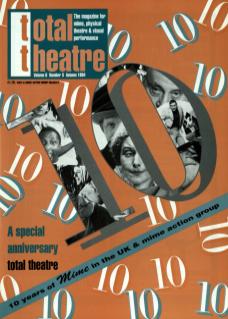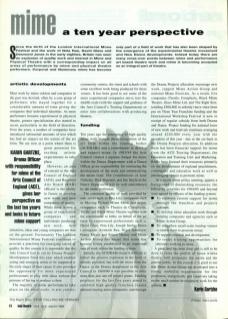Since the birth of the London International Mime Festival and the work of Nola Rae, David Glass and Desmond Jones in the early eighties, Britain has seen an explosion of quality work and interest in Mime and Physical Theatre with a corresponding impact on all areas of performance by mime and physical theatre performers. Corporeal and illusionary mime has become only part of a field of work that has also been shaped by the emergence of the experimental theatre movement and New Dance developments. Indeed today there are many cross-over points between mime and performance art based theatre work and mime is becoming accepted as an integral part of theatre.
Artistic developments
Most work by mime soloists and companies in the past was devised, often by a core group of performers who stayed together for a considerable amount of time giving the companies their individual identities. As more performers became experienced in physical theatre, greater specialisation also started to occur, particularly in the field of direction. Over the years, a number of companies have introduced substantial amounts of text which has had an impact on the nature of the artform. We are now at a point where there is great potential for exciting artistic experiments to take place.
However, an area of concern to the Arts Council of England (ACE) and Regional Arts Board (RAB) officers is the ability in future to develop new work and new companies of quality. While there is now a group of experienced companies and individuals producing new work, new initiatives, ideas and young companies are thin on the ground. Fortunately the London International Mime Festival continues to provide a platform for emerging talent of quality. In this context it is regrettable that the Arts Council had to cut its Drama Projects Development Fund this year which enabled young and emerging artists to be supported at the early stages of their career. It also provided the opportunity for more experienced professionals to play with ideas without the pressure of having to produce a show.
The majority of mime performances take place on the small-scale, i.e. at arts centres, community centres, in the street and schools, with some excellent work being produced for these venues. It has been good to see some of the more experienced companies move into the middle-scale (with the support and guidance of the Arts Council's Touring Department) or enter into collaborations with producing theatres.
Funding
Ten years ago the emergence of high quality mime work brought about recognition of the artform within the funding bodies (ACE/RABS) and a commitment to develop and support mime. In 1983/84 the Arts created a separate budget for mime within the Dance Department with a Dance Officer given responsibility for overseeing the development of the work and administering the mime fund. The contributions of Jane Nicholas, Dick Matchett, and Sue Hoyle in the Dance Department will be well remembered by the mime profession.
The consistent quality of work provided by solo artists such as Peta Lily, companies such as Moving Picture Mime Show, and newer companies such as Theatre de Complicite, Trestle and Black Mime Theatre together with the commitment to lobby on behalf of the artform by experienced professionals such as David Glass, Peta Lily, Joseph Seelig, Helen Lannaghan, Kenneth Rea, Nigel Jamieson, Penny Mayes, and Simon Murray and Mime Action Group has meant that mime has become firmly established as an important area of work within the funding system.
Initially, ACE / the RABs found it difficult to reflect the creative explosion in the level of subsidy provided, but with the move from the Dance to the Drama department at the Arts Council in 1989/90 it was possible to offer more than just one-off project grants. Funding priorities for the last five years aimed to establish high quality franchise funded national touring mime companies, and through the Drama Projects allocation encourage new work, support Mime Action Group and national Mime Festivals. As a result, five companies (Trestle, Complicite, Black Mime Theatre, Glass Mime Ltd, and The Right Size, totalling £568,800 in subsidy) have since been put on Three Year Franchise funding and the International Workshop Festival is now in receipt of regular subsidy from both Drama and Dance. Project funding for national tours of new work and festivals continues, averaging around £220,000 every year with the exception of this year – due to the cut back in the Drama Projects allocation. In addition there has been financial support for mime from the ACE Touring Department, the Education and Training Unit and Marketing. RABs have focused their resources primarily on the development of regional practitioners and community and education work, as well as encouraging venues to promote mime.
At a recent mime policy meeting, against a background of diminishing resources, the following priorities for 1994/95 and beyond were agreed by officers of the funding system:
- To maintain current support for mime through the franchise and projects schemes.
- To develop mime education work through existing companies and agencies such as Mime Action Group.
- To strengthen small-scale touring venues to enable them to promote mime.
- To support research and development.
- To create training opportunities for directors working in mime.
A great deal has been done and is still to be done to raise the profile of mime within theatre, with promoters, the media and the general public. In this context it is good to see that Mime Action Group has developed into a strong umbrella organisation for the profession, energetically and creatively taking on the much needed development work for the artform.

